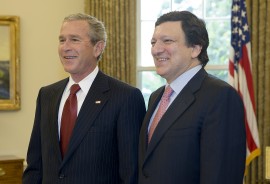
Comparing Europe and America is all the rage right now: can Europe stand up to America, should it take a leading role, that kind of thing. Here is a different comparison that all bears thinking about.
There is an interesting table in the book “The political system of the European Union” by Simon Hix (Palgrave, 2005) (order the book from Amazon here – it’s worth getting a copy) which compares the development of the competences of the EU over decades with those of the United States over centuries. I have taken the liberty of making a copy of the table, which you can find here: competences, competences and a colour version of it which might be easier to read, which you can find here: competencesincolour.
(You can see a comparison of the different institutional structures by Adrian Taylor here)
As far as the powers are concerned, it is striking to see that, over time, there has been a broad increase in the powers of the federal level of each side of the Atlantic. The pattern has been the same, but the process has been different. In Europe, there has been an integration process and so one would expect the powers of the federal level to increase as the realisation that individual member states cannot act alone sinks in. In America, though, the reason is often different.
Looking at the increase in the powers of the American federal government in the areas of regulation and expenditure, a major reason for the increase is that, going back two centuries, this kind of regulation and public expenditure was absent. The Europeans since the second world war have been knitting together established modern states, of a kind that simply did not exist in America, or anywhere else, 200 years ago. The powers at the federal level in the United States include a range of expenditure policies which are firmly national in Europe.
This difference is the answer to an important question, as I shall explain.
The reason why I am writing a discussion of the powers of the European Union today is because of the criticism that it has too many. On other occasions, I write about the criticism that it has too few.
It is possible to make a reasoned case that one EU power or another should be returned to the member states, but that depends on a detailed discussion of each individual case. More common is the complaint that, since the EU first alighted on the definition of subsidiarity in the Maastricht Treaty, not a single competence has been returned from the EU to the national level and that therefore the principle of subsidiarity is a sham. Instead, we are told, there is a continual push for centralisation for centralisation’s sake. I don’t agree.
First of all, where does the notion that subsidiarity in the EU should mean stripping powers from Brussels come from? Subsidiarity is about the right level, not the lowest level. It all depends on your starting position. If the transfer of powers has been from the national to the European level, isn’t that what European integration is for?
Secondly, I suppose that one might say that powers have not been returned to the national level yet, not that they will never be returned. There are very different timescales under consideration in the European and American cases, after all.
Thirdly, let me point to an example where the powers of the EU have indeed been cut back. The last budget deal agreed to reduce the EU budget from 1.24 to 1.05 per cent of EU GDP. That’s a 16 per cent cut. It’s not a change that will show up in Simon Hix’s chart, but it will make a lot of difference to the EU’s ability to do the things that Europeans need and want it to do, and it certainly proves that there is no conveyor belt to a centralised Europe.
The management of competition policy, too, has been decentralised, with the Commission dealing with only the biggest, most significant cases.
When it comes to representation in the WTO, the European Commission is the EU’s negotiating vehicle, but the member states are still involved. There was a case in the ECJ on this, and the Commission lost. So much for the “political court, always committed to furthering integration” argument.
Lastly, and perhaps most importantly, the roll-back of federal powers in the US is the result of a political process. It wasn’t a reaction against federal government powers in favour of state government powers, but a reaction against government powers as such. And this reaction could be expressed as a political choice at the federal level.
Where is the opportunity for European voters to express such a political choice? We get to elect the European Parliament, yes, but the connection between that and the political direction of the European Union is rather weak. The connection between the national elections, which produce members of the European Council, and the EU’s political direction is even weaker. If there is a problem highlighted by the comparison of the powers of the US and the EU, it is this. It is not that the EU has too many powers, but that it does not have enough democracy.
